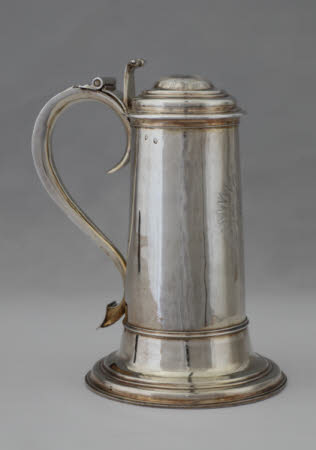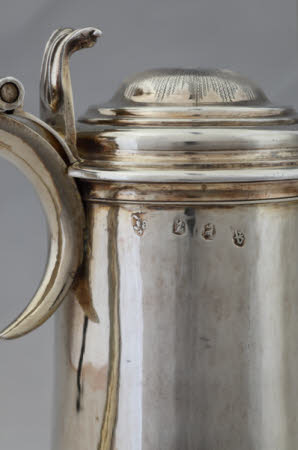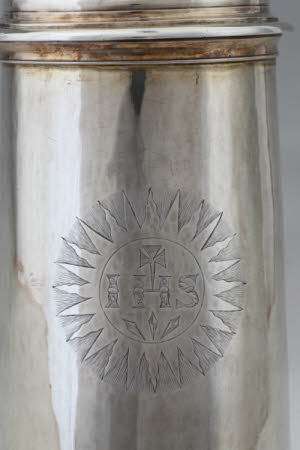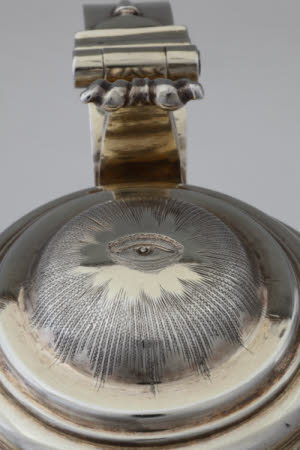Communion flagon
John Jackson I and John Fawdery I
Category
Silver
Date
1705 - 1706
Materials
Silver
Measurements
26.0 x 21.0 cm; 16.5 cm (Dia of base)
Place of origin
London
Order this imageCollection
Ickworth, Suffolk
NT 852903
Summary
Silver-gilt communion flagon by John Jackson I and John Fawdery I, London, 1705/6. The skirted and stepped foot is raised and has a moulded wire concealing the joint with the circular, slightly tapering body above, which is seamed and has an inset base and an applied moulding at the lip. The front is engraved with the sacred monogram, cross and nails within a sunburst or glory. The stepped and domed lid is raised and has an applied, seemed bezel. It is engraved with the ‘Eye of God’ – an eye in a sunburst. The tapering scroll handle is of D section and formed of a raised concave inner piece soldered to a flat cover strip. It has a curved shield-shaped heel plate soldered to the lower end. A cast three-part pin hinge is soldered to the top of the handle and has an arched connector to the lid, conforming to the curve of the handle, and a scroll thumb piece.
Full description
Silver by John Jackson is now comparatively rarely found but he seems to have been one of the more successful indigenous makers of the early 18th century. A pair of sconces of 1707 by him in the Museum of Fine Arts, Boston, formerly at Belton House in Lincolnshire, probably originated in the royal collection [1] and he supplied silver to the banker-goldsmith James Chambers over a number of years, as is evidenced by pieces with his mark at Ickworth. Plates and dishes destined for the newly ennobled Lord Hervey (later Earl of Bristol) were provided in 1703 (see NT 852124) and he went on to receive this flagon from Chambers in 1706, the entry in his accounts being as follows: July ye 5 Paid Chambers in full of his Bill for Ick: Church fflagon &c [£]19 The fact that the handle bears John Fawdery I’s mark and that Jackson appears to have stamped his over another’s on the lid implies that Fawdery was actually the maker of the flagon, and supplied it to Jackson. Further evidence of collaboration between the two exists in the form of a kettle of 1708 bearing Jackson’s mark while its undated stand has Fawdery’s.[2] Fawdery, who was also indigenous and had been apprenticed to Anthony Nelme, has rather more work surviving than Jackson and is revealed by it to have been an accomplished silversmith. He produced other sacred pieces, including a chalice and paten cover of 1714 also in the Museum of Fine Arts, Boston,[3] and such high quality domestic pieces as the chocolate pot of 1698 in the collection of the Salters’ Company.[4] Flagons ‘to fetch wine to serve the Lord’s table, reserved and kept clean to that use only, being no tavern pots’, are a post-Reformation vessel and were being recommended for use in Anglican churches by the end of the 16th century.[5] Thereafter they were either made with a bulbous, pear-shaped body or as a plain, slightly tapering cylinder. The latter form was almost exclusively followed in the first quarter of the 18th century and the only significant reflection of changing fashions could be found in the style of engraving. The church for which this flagon was acquired, dedicated to St. Mary, lies at the heart of the park of Ickworth House, adjacent to the site of the mediaeval manor house and presumably in the vicinity of the lost village. Its chancel is of the 13th century, the tower was rebuilt by the 3rd Earl in 1778 and major refurbishments and alterations were carried out in the 1830s and in 1909-10, the latter being overseen by Arthur Blomfield who also worked on the house.[6] Having been declared redundant in 1984 and falling into disrepair thereafter, the building was vested in a charitable trust by the present, 8th Marquess of Bristol in 2006 and subsequently restored. The interior is dominated by the memorial stones to the Herveys who are buried in the vault beneath the family pew in the south aisle. Amongst them is that of the 1st Earl of Bristol, who gave the flagon. For the other items of plate from Ickworth church, all given by the Herveys, see 852904, 852905 and 852906. James Rothwell, Decorative Arts Curator April 2020 Taken from the text of James Rothwell, Silver for Entertaining: the Ickworth Collection, London 2017, cat. 6, pp. 73-4. Notes [1] Ellenor Alcorn, English Silver in the Museum of Fine Arts Boston, vol. II Silver from 1697, Boston 2000, cat. 19, pp. 70-1. [2] Timothy Schroder, British and Continental Gold and Silver in the Ashmolean Museum, Oxford 2009, p. 764. [3] Ibid, cat. 27, pp. 80-1. [4] Graham Hughes, Treaures at Salters’ Hall, Alfriston 2000, p. 105, ill. [5] Sophie Lee and Alec Ryrie, ‘The Tudor Reformations’ in Timothy Schroder (ed.), Treasures of the English Church, London 2008, pp. 34-5. The quote is from Archbishop Whitgift’s 1597 articles for the Deanery of Shoreham. [6] Kate Yates, Ickworth Church: A History, Ickworth 2013, pp. 4-5.
Provenance
John, 1st Lord Hervey (subsequently 1st Earl of Bristol); given by him to the church of St Mary, Ickworth, probably in 1706; transferred to the church of St Leonard, Horringer in 1984; on loan to the National Trust at Ickworth House from 1998.
Credit line
St Leonard, Horringer, on loan to the National Trust
Marks and inscriptions
On the side of the body and the underside of the lid: Maker’s mark ‘Ia’ above a cross (Arthur Grimwade, London Goldsmiths 1697-1837, London 1990, no. 1092), Britannia, leopard’s head erased and date letter ‘k’ for 1705/6. Underside of the flagon: Leopard's head erased (London assay mark, Britannia version) Handle: Maker’s mark ‘FA’ for John Fawdery I (Arthur Grimwade, London Goldsmiths 1697-1837, London 1990, no. 662).
Makers and roles
John Jackson I and John Fawdery I, goldsmith John Jackson I, goldsmith John Fawdery I (fl.1695 - 1723), goldsmith



